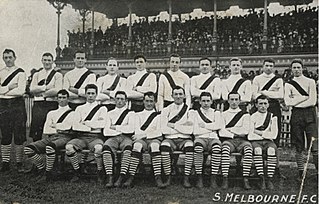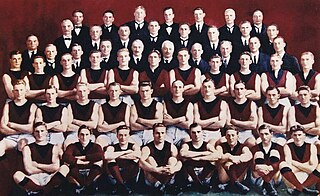Related Research Articles

The Carlton Football Club, nicknamed the Blues, is a professional Australian rules football club based at Princes Park in Carlton North, an inner suburb of Melbourne in Victoria, Australia. The club competes in the Australian Football League (AFL), the sport's premier competition.
Dale Weightman is a former Australian rules footballer who played for the Richmond Football Club in the Australian Football League (AFL).
Stephen Scott Kernahan is a former Australian rules footballer who played for the Carlton Football Club in the Australian Football League (AFL) and for the Glenelg Football Club in the South Australian National Football League (SANFL). He also played 16 State of Origin games for South Australia and gained selection as an All-Australian five times. He later served for six years as president of the Carlton Football Club.

Neil Allen Balme is a former Australian rules footballer who played for the Richmond Football Club in the Victorian Football League (VFL), as well as for the Subiaco Football Club in the Western Australian National Football League (WANFL) and the Norwood Football Club in the South Australian National Football League (SANFL).

The 1909 VFL season was the 13th season of the Victorian Football League (VFL), the highest-level senior Australian rules football competition in Victoria. The season featured ten clubs and ran from 1 May to 2 October, comprising an 18-match home-and-away season followed by a four-week finals series featuring the top four clubs.

The 1920 VFL season was the 24th season of the Victorian Football League (VFL), the highest-level senior Australian rules football competition in Victoria. The season featured nine clubs and ran from 1 May to 2 October, comprising a 16-match home-and-away season followed by a four-week finals series featuring the top four clubs.

The 1922 VFL season was the 26th season of the Victorian Football League (VFL), the highest-level senior Australian rules football competition in Victoria. The season featured nine clubs and ran from 6 May to 14 October, comprising a 16-match home-and-away season followed by a four-week finals series featuring the top four clubs.

The 1923 VFL season was the 27th season of the Victorian Football League (VFL), the highest-level senior Australian rules football competition in Victoria. The season featured nine clubs and ran from 5 May to 20 October, comprising a 16-match home-and-away season followed by a four-week finals series featuring the top four clubs.
The 1962 VFL season was the 66th season of the Victorian Football League (VFL), the highest level senior Australian rules football competition in Victoria. The season featured twelve clubs, ran from 21 April until 29 September, and comprised an 18-game home-and-away season followed by a finals series featuring the top four clubs.
The 1931 VFL season was the 35th season of the Victorian Football League (VFL), the highest-level senior Australian rules football competition in Victoria. The season featured twelve clubs and ran from 2 May to 10 October, comprising an 18-match home-and-away season followed by a four-week finals series featuring the top four clubs.
The 1967 VFL season was the 71st season of the Victorian Football League (VFL), the highest level senior Australian rules football competition in Victoria. The season featured twelve clubs, ran from 15 April until 23 September, and comprised an 18-game home-and-away season followed by a finals series featuring the top four clubs.
The 1969 VFL season was the 73rd season of the Victorian Football League (VFL), the highest level senior Australian rules football competition in Victoria. The season featured twelve clubs, ran from 5 April until 27 September, and comprised a 20-game home-and-away season followed by a finals series featuring the top four clubs.

The 1949 VFL season was the 53rd season of the Victorian Football League (VFL), the highest level senior Australian rules football competition in Victoria. The season featured twelve clubs, ran from 16 April until 24 September, and comprised a 19-game home-and-away season followed by a finals series featuring the top four clubs.
The 1947 VFL season was the 51st season of the Victorian Football League (VFL), the highest level senior Australian rules football competition in Victoria. The season featured twelve clubs, ran from 19 April until 27 September, and comprised a 19-game home-and-away season followed by a finals series featuring the top four clubs.
The 1973 VFL season was the 77th season of the Victorian Football League (VFL), the highest level senior Australian rules football competition in Victoria. The season featured twelve clubs, ran from 7 April until 29 September, and comprised a 22-game home-and-away season followed by a finals series featuring the top five clubs.
The 1972 VFL Grand Final was an Australian rules football game contested between the Richmond Football Club and Carlton Football Club at the Melbourne Cricket Ground on 7 October 1972. It was the 75th annual Grand Final of the Victorian Football League, staged to determine the premiers for the 1972 VFL season. The match, attended by 112,393 spectators, was won by Carlton by a margin of 27 points, marking that club's 11th premiership victory.
The 1973 VFL Grand Final was an Australian rules football game contested between Carlton and Richmond at the Melbourne Cricket Ground on 29 September 1973. It was the 76th annual Grand Final of the Victorian Football League (VFL), staged to determine the premiers for the 1973 VFL season. Although Carlton were the favourites to win, it was Richmond who would take the flag by 30 points, marking that club's eighth VFL/AFL premiership victory.
The 2013 Carlton Football Club season was the Carlton Football Club's 150th season of competition, and 117th as a member of the Australian Football League. It was the first season coached by new coach Mick Malthouse, who replaced Brett Ratten after the club failed to reach the finals in 2012. Carlton finished sixth out of eighteen teams for the 2013 AFL season, after finishing eighth after the home-and-away season.
The 1972 Carlton Football Club season was the Carlton Football Club's 109th season of competition, and 76th as a member of the Victorian Football League. Carlton fielded teams in the senior, reserves and under-19s grades of the 1972 VFL season.
The 1982 Carlton Football Club season was the Carlton Football Club's 119th season of competition, and 86th as a member of the Victorian Football League. Carlton fielded teams in the senior, reserves and under-19s grades of the 1982 VFL season, and its senior team also contested the 1982 Escort Championships.
References
- 1 2 3 Bowen, Nick (14 June 2014). "John Nicholls voted greatest Blue of all time". AFL Media.
- ↑ "Legends". AFL.com.au. Archived from the original on 21 April 2013. Retrieved 2 October 2014.
- ↑ "Big Nick and Ragsy". The Age. 30 August 2007.
- ↑ Don Nicholls Profile
- ↑ Phillips, Stephen (18 July 1977). "Five votes off a grand slam". The Age .
- ↑ "No panic changes, says Nicholls". The Age . Melbourne. 26 September 1972. p. 22. Retrieved 24 June 2012.
- ↑ Connolly, Rohan (25 September 2001). "Blues by a cricket score". The Age.
- ↑ "Preliminary Final, 1972". Blueseum. Retrieved 2 October 2014.
- 1 2 3 4 Beames, Percy (10 October 1972). "Carlon's flag... and how!". The Age.
- ↑ "Carlton ruckman John Nicholls goes down". Herald Sun. 20 June 2008.
- ↑ "Ferocious rivalry the making of a big hit". The Australian . 7 September 2013.
- 1 2 Connolly, Rohan (7 May 2005). "The bad blood that won't wash away". The Age . Melbourne.
- ↑ "Star Footballer Gaoled for Embezzlement". The Age . 8 April 1960. p. 4.
- ↑ Fiery Quarter Lifts Dull Game, The Age, 18 July 1960, p.18.
- ↑ Cartledge, 2013, p. 59
- ↑ Hawthorne, Mark (13 August 2010). "Great says Blues not in great Nick".
- ↑ Pierik, Jon (15 June 2014). "John Nicholls says Carlton needs to shed arrogant image". The Age.
- ↑ "Teague wins Carlton best and fairest". The Sydney Morning Herald. 9 September 2004. Retrieved 13 October 2009.
- ↑ Team of the Century [usurped]
- ↑ AFL Record Guide to Season 2005; Lovett, Michael (editor); p493
- ↑ "The Game That Made Australia". Australian Football League. Archived from the original on 19 April 2013. Retrieved 19 September 2010.
- 1 2 Flanagan, Martin (28 August 1999). "The Grand Final of the Century 1970 (Part One)". The Age .
- ↑ Cartledge, 2013, pp.57-58